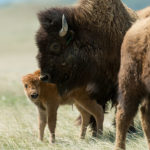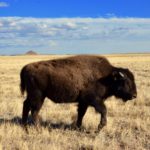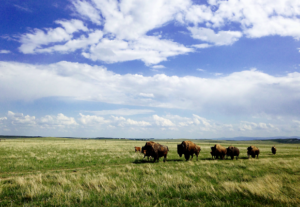
In November 2015, an unprecedented experiment led by Colorado State University started about 25 miles north of Fort Collins. Bison, once native to the area, had been absent for over a century. That changed when the Laramie Foothills Bison Conservation herd was released onto a 1,000-acre pasture at Soapstone Prairie Natural Area and Red Mountain Open Space.
The monumental effort, the result of numerous partnerships, also provides unique research opportunities. Kate Wilkins, a Ph.D. candidate in ecology in the Warner College of Natural Resources, is studying the ecological and social impacts of reintroducing bison on the prairie.
“We still look for connections to this place,” said Charlie Gindler, a Larimer County Department of Natural Resources resource specialist and second-generation Larimer County rancher. “Sometimes making those connections takes a catalyst.”
According to Gindler, the reintroduction of the bison — whose genetics come from in and around Yellowstone National Park — is the catalyst for many people to better connect with the land. He said the bison have struck a chord, beyond the important conservation role the herd plays.
“There’s something primal about connecting with this herd that’s reestablishing themselves in their native territory,” he added. “I think we feel an identification with that.”
Bison’s role in prairie ecology
Wilkins began her research on the area prior to the reintroduction to establish a baseline. “I’m looking at birds, mammals and plants, and how they’re affected by bison,” Wilkins said.
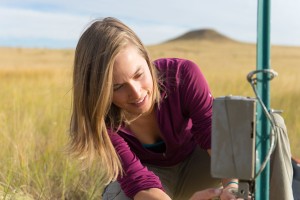
The CSU team conducted wildlife surveys using 60 cameras spread throughout the bison’s range. This generated 174,000 photos in a single season. Wilkins and researchers are still reviewing more than 80,000 images to differentiate data points of animals from photos of grass blowing in the wind, which also triggered the motion-sensing cameras. But those photos of wildlife and bison, needles in the haystack, are where the picture of the bison’s ecological impacts begins to form.
When coyotes, pronghorns, or other animals wander through, it’s a chance to see how species are reacting to the presence of the bison. “It’s gauging, now that bison are out on the landscape, how these mammals are changing the use patterns out on this space, if at all,” Wilkins said.
It’s still early to draw conclusions, but Wilkins’ aim is to understand what reintroducing a native species can accomplish: Will return of the bison assist in maintaining a stable prairie ecosystem? The bison’s use of an area can have “cascading effects on the birds and mammals using that space,” she said.
Collaborative effort
One group alone couldn’t accomplish a research project of this magnitude. “It’s a hugely collaborative effort,” Wilkins explained.
The CSU researcher is working with Denver Zoo to collect data about the reintroduction’s social impacts, meaning people’s attitudes, perceptions and connections that they are making with the land following the reintroduction. She’s also working closely with Larimer County and the City of Fort Collins, which manage the areas on which the bison now reside.
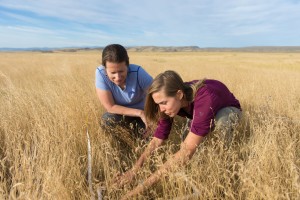
Wilkins is also collaborating with CSU’s College of Veterinary Medicine and Biological Sciences and, more specifically, Jennifer Barfield, a reproductive scientist with CSU’s Animal Reproduction and Biotechnology Laboratory, who pioneered the effort to create the new embryos to get the herd back onto the native prairie.
Undergraduates gain experience
The project has also given undergraduates in the Warner College field research experience. They’ve been charged with collecting samples and analyzing images to collect data points.
Wilkins said she’s enjoyed introducing students to research and mentoring them. “I wouldn’t be able to do it without them,” she said.
Miranda Kurtz, a senior fish and wildlife conservation biology major, and Molly Warner, a senior earning a degree in conservation biology, worked with Wilkins last summer.
Warner assisted with bird, wildlife and vegetation surveys. “Her work is really cool,” Warner said when asked about working with Wilkins. “She’s one of the only people studying this herd’s impacts on the land.”
Many people who have seen the bison talk about personal connections they’ve developed with the herd and the land.
Barfield, at a Nov. 1 event celebrating the herd’s first anniversary at Soapstone Prairie, recounted watching the herd wander off for the first time and wanting to know if they’d be OK.
Her thoughts were reminiscent of parents when they send their children off to school.
